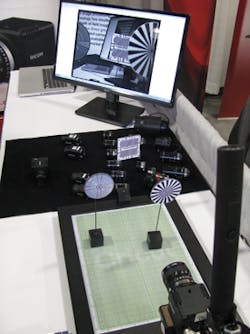Image Capture: Extended depth of field cameras shown at Vision Show
In many production line inspection applications, objects of varying heights may be required to be imaged. To accomplish this, camera systems with a large depth of field (DOF) must be used to ensure that both near and far objects in the field of view of the camera remain acceptably sharp.
Although a lens will only precisely focus at only one specific distance, there is a gradual decrease in sharpness at either side of the focused distance. Within this depth of field, the difference in sharpness will be negligible allowing near and far objects to be captured and analyzed by machine vision software.
In conventional lenses, this DOF varies depending on the aperture and focusing distance. Decreasing the aperture of such a lens, for example, will result in increasing the DOF.
In machine vision applications, however, decreasing this aperture may require that additional lighting be used to properly illuminate the object being imaged.
When imaging objects where such large DOFs are required, systems developers can opt to use multiple cameras on production lines. Alternatively, autofocus cameras can be used to accommodate the differences in focal length required by parts of different sizes.
Engineers at HAHN Automation (Hebron, KY, USA; www.hahnautomation.com) have used such cameras, for example, in a system designed to inspect power pack assemblies (see "Vision assists power steering assembly", pp. 27-31, this issue).
At this year's Vision Show, held in Boston, Ricoh (West Caldwell, NJ, USA; www.ricoh-usa.com) demonstrated a very different way of extending the depth of field in the company's recently introduced EV Series of cameras.
Although Ricoh engineers were reluctant to divulge the exact details of their design, the camera series incorporates specialized lenses and a camera with in-built image processing capability.
Both the UXGA and VGA image sensors offered with the cameras must be fitted with the company's own lenses of 8.5mm, 12mm and 35mm focal lengths. Because these lenses have a central obstruction and part of the aperture will be blocked, an adjustable iris cannot be used and thus the aperture of each of the individual lenses is fixed at f/#1.2.
Three versions of its extended depth of field cameras are offered by the company. The first, the EV-G200C1 is a 1624 x 1236 1/1.8in interline GigE Vision-based CCD monochrome camera with frame rates of up to 15fps. A color version of the camera, the EV-G200C1 is also available.
Lastly, the EV- G030B1 is a monochrome 648 x 494 1/1.8in interline GigE Vision-based CCD camera with frame rates of up to 89 fps.
At the Vision Show, Ricoh demonstrated how the cameras could be used to simultaneously image different test targets separated in the cameras field of view by a range of several centimeters.
The company's website also shows a number of different applications of how the camera can be configured to image oblique objects and multiple objects at different distances (http://bit.ly/RCAh0t).
Vision Systems Articles Archives

